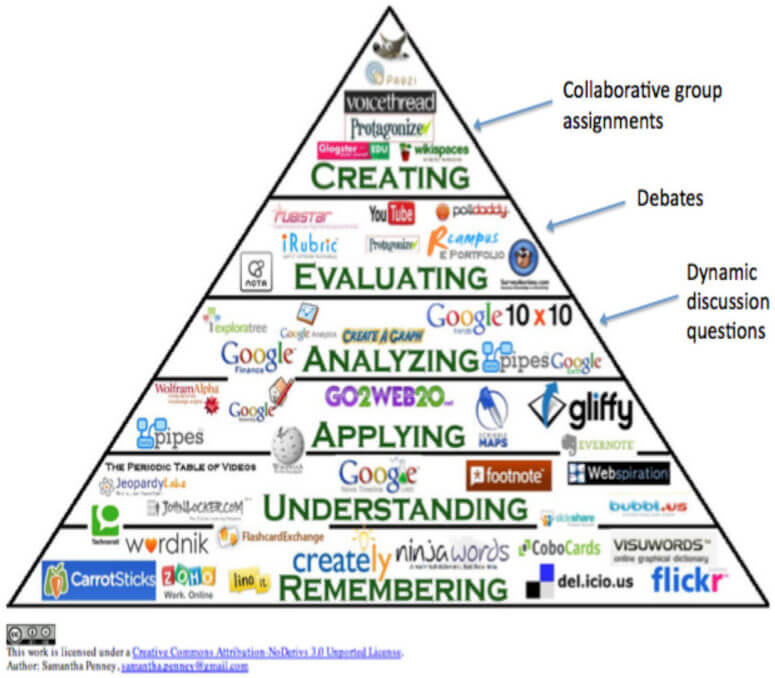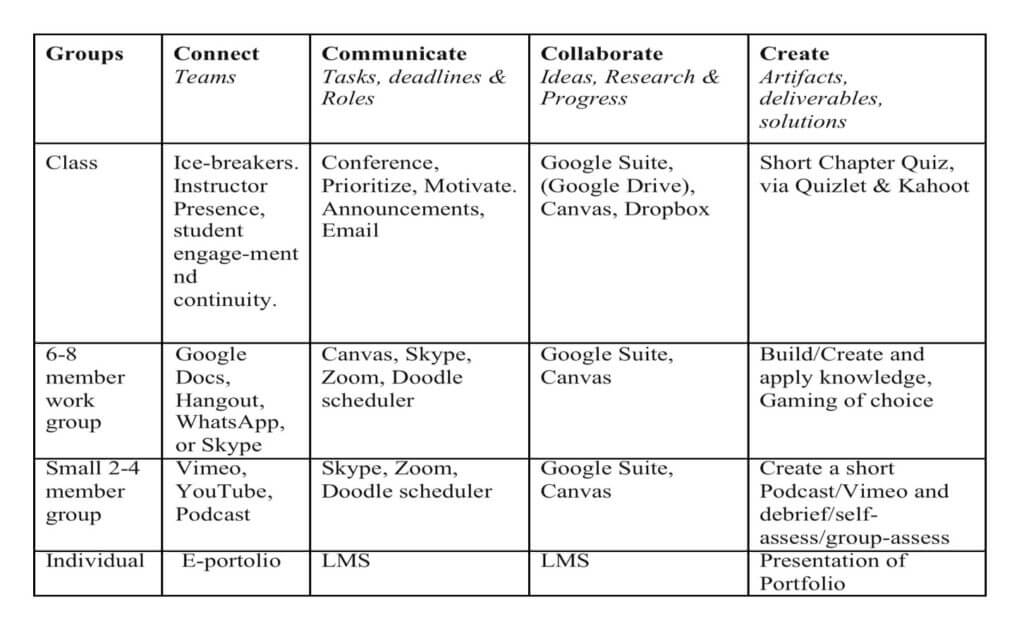Reimagining Meaningful Online Class Interactions Utilizing Technology
Published in:
November 22–23, 2019
University of Miami
Miami, Florida
Introduction
The article will share the experiences of the presenter’s 2019 study at Clark Atlanta University (CAU) teaching the core course CHED 600: Administration & Governance of Higher Education to doctoral students in the Higher Education doctoral program. These 13 students were older, higher education/business professionals who were in the higher education leadership doctoral, hybrid program. The students were capable, but preferred to work alone or in very small groups. They also preferred to know the exact format, number of pages, margins, number of references, etc. A small number of the students needed some redirection or turned in late work, thereby receiving grade reductions. Since it was a graduate course, anything less than a B was failing and the researcher did not grade on a curve. With major assignments, students were encouraged to submit assignments work early for review and feedback, prior to the final due date, within certain limitations.
Background
Clark Atlanta University (CAU) is a single, comprehensive, urban, private, coeducational, United Methodist-affiliated Historically Black College and University (HBCU) in the United States. The campus has 38 areas of study in four major schools, including arts and sciences, business, education, and social work. The university also has an award-winning Center for Cancer Research and Therapeutic Development, and enjoys more than 3,500 undergraduate and graduate students of diverse racial, ethnic, and socioeconomic backgrounds. CAU offers certificate, professional, and degree programs from BA/BS to EdD/PhD. On September 1, 2019, the new president of CAU, Dr. George French, became the fifth person to hold that position. CAU is one of five schools that compose the Atlanta University Center. The other four schools are Spelman College, Morehouse College, the Interdenominational Theological Center, and the Morehouse School of Medicine.
Dr. Barbara Hill, Associate Dean of the School of Education and Chair of the Educational Leadership program; Mary Hooper, Associate Vice President of Online Learning & Continuing Education; and Dr. Markeshia Henderson, Director of the Center for Innovative Teaching, Learning & Engagement, generously provided their time and talents for the benefit of faculty interested in educational technology. Tailor-made teaching and learning technology workshops are available for faculty at various stages of development. Weeklong faculty training is offered in the summer, with shorter training offered throughout the year. As members of one of the Faculty Resource Network (FRN) participating institutions, faculty can write proposals to attend professional development seminars, symposia, conferences, and summer residencies, sponsored by New York University in the winter, summer, and fall. This researcher has benefitted from these opportunities for the past few years. This article is an extension of a presentation this researcher conducted at the FRN Winter Symposium on November 2019, in Coral Gables, Florida.
Course Description
The doctoral course explored models of governance in higher education, their relative efficiency and the factors that might explain their adoption by particular institutions. The course also provided an overview of some of the demographic, social, legal, financial and planning issues and forces, and examined how they affected the way colleges and universities were governed. Academic and Administrative Unit Governance within higher education were explored, as well as the policy implications as it related to college governance.
Signature Project
Students completed a project-based case study assignment where they were assigned a state university system and an institution within that state system, to develop a practical and theoretical framework illustrating the principles of administration and governance, among and between the state, institution, faculty, and external environment.
My intent was to have them fully describe, analyze, and evaluate the system in terms of administration, organizational structure and governance. They had parameters/elements of their framework, organizational chart, what general categories requirements were to be included for full credit, a solid rubric based on the objectives of the course, supporting documents, and their presentation of the case study. Each student produced an interactive case study and documents utilizing a variety of online technologies and platforms, most of which can be found in Bloom’s Social Media Taxonomy chart below.
Blooms Social Media Taxonomy

Learning Objectives of the Project
With reference to Bloom’s taxonomy, the learning objectives of the project were as follows:
- Assess (Create) the relative effectiveness of governance models in achieving their stated expected goals.
- Recommend (Evaluate) appropriate governance models for institutions in a variety of environmental and demographic situation.;
- Identify (Analyze) and explain the leadership characteristics needed by administrators to be effective managers in different governance models.
- Explore (Apply) the ways in which the federal and state role affects the governance of colleges and universities and how that role has been changing;
- Understand the main features of the types of state governance structures, along with their strengths and weaknesses.
- Explain (Remember) the impact of external and internal stakeholders in higher education upon the governance of higher education.
Students were assigned one of 6 University Systems, from which they could select one specific institution. Those assigned the same state system, could work collaboratively on that portion, but the institution-specific work could only be done individually. Students were asked for their priorities or preferences of studying a large, public university, a small, private college or university, or a community college. Every effort was made to meet student preferences.
The Case Studies were meant to be intensive and extensive, as well as thorough in both depth and breadth. They required detailed, thoughtful description and analyses of the institution, including its mission, objectives, policies, programs, curricula, administrative structure(s) (how it is organized), and the nature of its governance model. This study culminated in a paper of roughly 4,500 words and a 15-20 minute presentation. This Case Study Signature Assignment met 10 of the 13 learning objectives of the course.
The flexibility in the design of the student teams, helped to facilitate a well-organized and easy to follow structure based on topics, weekly forums, and clearly defined, weekly deliverables. A collaborative space was made available for students to chat and discuss, both synchronously and asynchronously, to help build a cohesive community of learners. A separate student forum was established to encourage socializing thru introductions and ice-breakers. The professor did define the parameters of the discussion forum, but the students were given the opportunity to create additional topics, moderate and facilitate these discussions. Each student rotated their roles in the forums and served as a Designer, Facilitator, Teacher, Moderator and Evaluator. Students also used the Discussion Forums as a space to collaborate on small-group projects that aligned with the higher levels of Bloom’s taxonomy. Below is a chart of the 4 types of groups and how they connected, communicated, collaborated and created to complete their final deliverables.

The final chart below identifies the student activity (assignment) using problem-based design, as well as how students chose to engage with the course content, select assessment strategies, and utilize the tools and technologies in this hybrid course.

The researcher wishes to thank Ms. Anne Ward and Drs. Barbara Hill, Mary Hooper, and Markeshia Henderson, and Mr. Omar Harbison for their support of the researcher’s participation with the FRN and her work on this research project.
Spring 2020: Critical Conversations and the Academy
